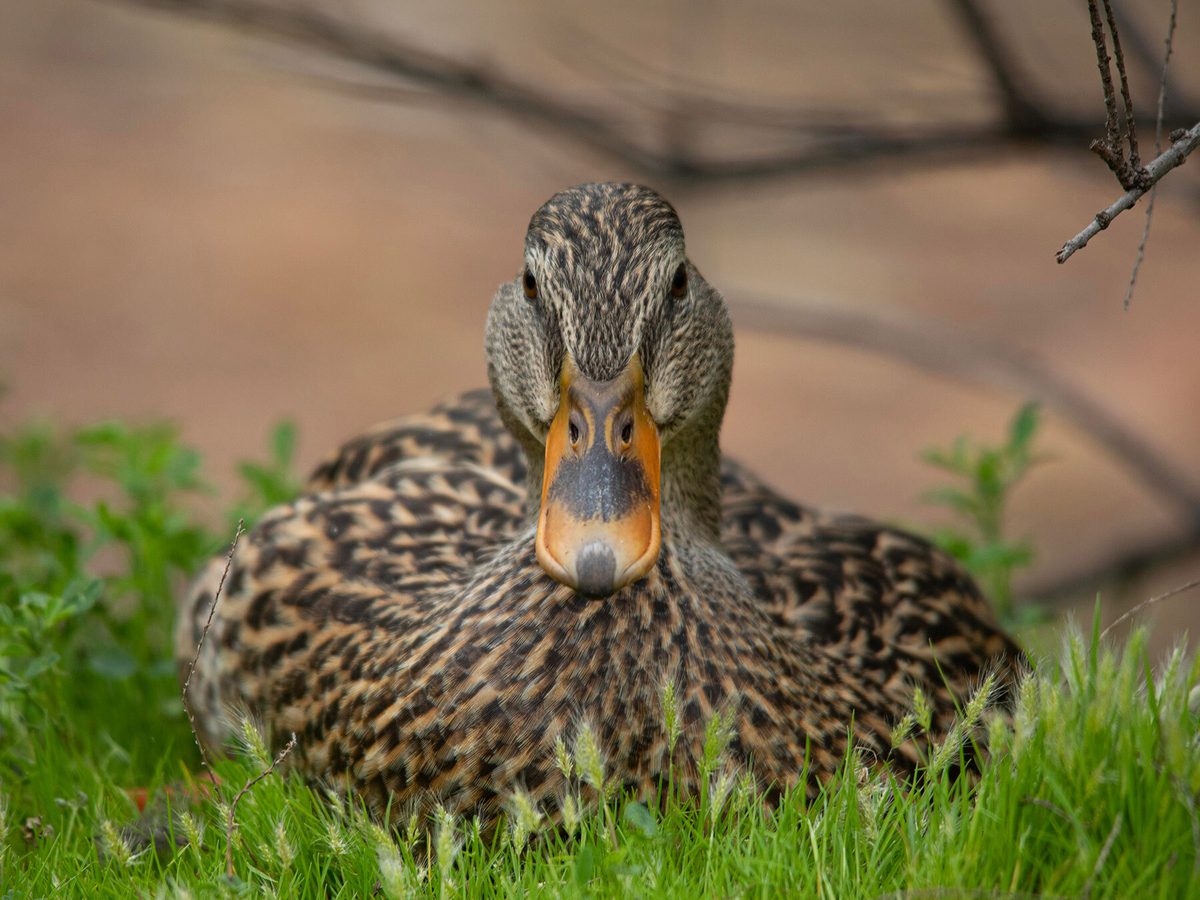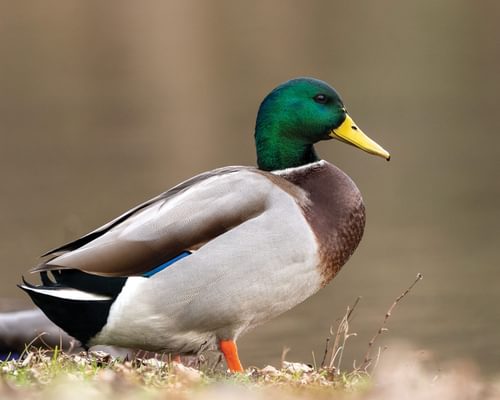While male mallards, with their lustrous green heads, white neck collars, and chestnut breast feathers, are instantly identifiable to bird experts and nonexperts alike, the same cannot be said for female mallards. From a distance, females may be easily confused with several other large pale brown ducks.
Here we take an in-depth look at female mallards, with a guide to their nesting, feeding, and breeding habits, so you can become an expert at identifying the species, even from way across a lake or pond.
How can you tell if a mallard is male or female?
In winter and spring, telling a male mallard from a female is simple. Male mallards are one of the most recognizable duck breeds in the world. They are easily identified, with an iridescent green head, pale gray body, black curled tail feathers, chestnut breast, and thin white collar around their necks.
In contrast, female mallards are rather more nondescript, with mottled brown feathers all over, darker lined markings around the eyes, and pale whitish tail feathers. Both males and females have a flash of violet-blue feathers on each wing, tipped with black and white bands.

Female Mallard

Male Mallard
Each year, in later summer, male mallards undergo a temporary change of plumage, known as an ‘eclipse molt’. They lose their bright feathers and adopt a far more subdued appearance, with a mottled green head that later turns fully brown. This process allows them to blend into their surroundings and keep themselves safe from predators.
Males in eclipse molt can still be distinguished from females with relative ease, as they retain a solid yellow bill, as opposed to the blotchy orange-brown bill of a female mallard.

Close up of a young male mallard in eclipse plumage
What does a female mallard look like?
Female mallards are a mottled brown, with darker brown feathers on their heads. They have a violet-blue wing flash (known as a “speculum”) tipped with black and white bars. Their underparts are paler, and their tail feathers are white.
Female mallards have orange-red legs and feet. Their bills are a brownish-orange shade, marked with black splodges.

Female Mallard swimming on the lake
What is a female mallard duck called?
A female mallard is known as a hen or a duck, while a male is called a drake.
Are female mallards bigger than males?
Adult female mallards are on average 58 cm (23 in) in length and weigh 1.1 kg (2.4 lbs). Males are slightly larger and heavier, measuring 63 cm (24.7 in) and weighing 1.2 kg (2.7 lb).

Female mallard (left) and male (right)
Behavior differences
Both male and female mallards can display particularly aggressive behavior during the breeding season. Male mallards significantly outnumber females, and have an innate instinct to mate. Unpaired females are regularly and often particularly violently targeted by males for ‘forced mating’.
One explanation for this gender imbalance in the mallard population is that a significant number of females die in the period immediately after nesting, due to ‘nutritional stress’ (failing to find food resources with sufficient nutrients to meet their body’s requirements).
Female mallards may also die as a direct result of forced copulation, where the stress of the brutal attack can kill the female or she may even be drowned during the mating process.

Portrait of a female mallard
Singing and calls
Vocalizations differ between male and female mallards. Females have a wider repertoire, and are well-known for the noisy ‘quacking’ sound typically associated with ducks.
They make this sound between 2 and 10 times in succession, starting off as a harsh, loud sound, and then becoming softer and calmer. It is used as a mating call, and can also be heard as laying is about to commence. This is thought to signify that she is claiming her territory.
Male mallards don’t quack and instead make a weaker, rasping call. Mallard ducklings make a soft, high-pitched whistling sound, and respond to the female’s quacks that are used as a form of communication so they are aware of where she is, even when out of sight.
Nesting
Female mallards are dominant when selecting a nesting site, where alone they construct a shallow scrape, in sheltered vegetation near to water, well-hidden from view of predators.
While laying is ongoing, the nest site is guarded by the protective male; however, once the clutch is complete and the female begins incubation, the male mallard’s input is finished and he retreats to his summer molting ground.
Females mallards incubate their eggs alone for between 22 and 30 days. During this time, they need to leave their nest unattended to feed themselves for up to an hour twice a day.
It is the sole responsibility of the female to care for the ducklings once they have hatched, leading them to water where they are able to feed themselves straight away. The female parent remains nearby, keeping a watchful eye on her young for the first 6 to 8 weeks.

Female Mallards raise and care for the chicks on their own
Feeding
During the breeding season, male and nonlaying female mallards typically eat a diet that is one-third animal matter (insects, crustaceans, and worms), and two-thirds plant matter. Food eaten by laying female mallards, in contrast, is more than 70 percent animal-based.
For both males and female mallards during autumn and winter, plants form the largest proportion of the diet. Both male and female ducklings depend largely on insects until they are around two months old.
Can female mallards raise young alone?
Female mallards raise their young single-handedly. Shortly after laying is complete, males move on to their molting grounds, while females are left to incubate eggs and subsequently raise the ducklings for their first few weeks of life. Males typically play no active role beyond initially guarding a nest site until the female has finished laying the clutch.

Close up of a female mallard stood on a rock
Can a male duck turn into a female?
Male mallards do not turn into females, but do undergo a change of plumage that makes them lose their distinctive bright feathers and become more similar in appearance to females.
During what is known as the ‘eclipse molt’, males take on a dull, brown appearance in order to easily camouflage themselves against their marshland molting grounds. Initially their heads retain a greenish tinge, but this is gradually replaced with a full set of brown feathers.
Males in eclipse molt can be distinguished from females by looking at their beaks: regardless of their plumage, a male mallard will always have a yellow bill, while the female’s remains orange-brown speckled with black.
Each fall, male mallards molt again, regaining a set of the colorful feathers traditionally associated with mallard drakes, ahead of the upcoming breeding season when they rely on using their more impressive plumage to attract a mate.

